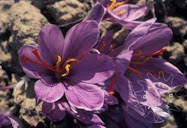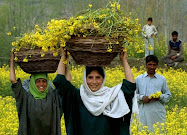For the last a few days I got incidentally clicked with some posts on certain blogs by some Kashmir Muslim youth who support the separatist movement in Kashmir. I got interested in knowing their sentiment in the first hand on the issue and engaged with comments and counter comments in some arguments presented by them. The crux of the matter that I could gather is that these youth are particularly nurturing a worst disdain for India and her presence in Kashmir by calling it an illegal Indian domination of Kashmir. They want immediate withdrawal of Indian troops and security personnel from her soil to have a free hand in all the affairs of the valley. They consider the insurgency their freedom struggle and call the armed militants from Pakistan and the other part of Kashmir (POK) freedom fighters that are helping the people of Kashmir to get rid of the so-called Indian domination in Kashmir. They often refer to some authentic historical facts including the UN resolutions on Kashmir that recommend self determination of the future of Kashmir by the people of the state. The spirit of the movement on the face of it seems genuine and any third person would definitely support the movement on its merits. But there is definitely another more important aspect of the situation that needs to be put forward along with the above for the establishment of an opinion by an unconcerned reader in the matter. I would like to lay down the following facts of the situation for healthy discussions if any:
The current insurgence in Kashmir is two decade old now and the situation has invited substantial worldwide attention and the international media is busy in making almost daily one or the other breaking news out of the Kashmir situation. The fact is equally established that the movement is actively supported and sponsored by the neighbouring country Pakistan both overtly and covertly according to certain game plan and does not enjoy a full popular public support. The masses in Kashmir are not totally disgusted with India as they understand that Kashmir with negligible financial resources cannot sustain independently and the other option Pakistan, itself a failed state with a fundamentalist background cannot keep them going. They understand precisely that Pakistan does not have any sympathy for the people of Kashmir. They are simply bent upon settling certain old scores with India and bank upon the religious sentiment of the Muslim majority of Kashmir. But they sincerely understand the magnanimity of India trying her best in building Kashmir through speedy developmental and management process by spending public money to the tune of thousands of crores every year despite all odds along side the extension of Indian liberal democratic setup to make the people elect their own representatives in order to run the local administration as well as make and amend laws for the state. There is the article 370 of Indian Constitution in force in the State to ensure no demographic changes whatsoever. No Indian non-Kashmiri can settle in Kashmir by law while a Kashmiri can settle do business and purchase property in any part of India.
It’s also an open secret that common people are unable to give vent to their feelings for the fear of the gun yielding youth who wander fearlessly and enforce their personal writ. The common man is equally desperate with the presence of these hordes of unruly gunmen having no respect for any human rights and is compelled to entertain all their whims and follies. How has he been suffering at the hands of these so-called freedom fighters is a long story of woes that nobody would like to hear. Every day in and out there are reports of illegal border crossing by highly motivated and trained militants in large numbers who after playing hide and seek with Indian security at the LOC or IB succeed in entering Kashmir and create havoc with the civilians and security agencies equally. The security agencies often receive authentic reports from local residents about the presence of these foreign mercenaries in different locations and the forces carry out action to liquidate them. The militants often hide in civilian houses or religious places to prompt more and more causalities on the security forces besides public wrath on civilian causalities if any. This situation is an unending process with Indian forces and foreign mercenaries continually on virtual warpath and the resultant suffering of the people. This is what the separatists call freedom struggle. Often when the people come on roads to protest against some civilian killings the separatist leaders exploit them to sing their own song of independence and violation of human rights. The prominent leaders of the movement are the people who’ve benefited largely in the bargain by becoming important public figures. Their living standards have prominently improved as they’re seen living in posh houses in Kashmir and owning properties worth hundreds of crores in most Indian metros with no obvious sources of income. Their own sons and daughters are out of the valley or abroad enjoying their parents’ reputation and wealth.
The current target of influence of these separatist elements sponsored actively by Pakistan is the educated youth of Kashmir. Being a soft target and unaware about the basic facts of the Kashmir and world situation these novices are easily carried away by the religious exploitation and fall into the trap of these cunning schemers who use them for their own ulterior motives. They get easily convinced over the theory of hatred for India on the basis of religion. They’re not given any occasion to grasp the facts about India in Kashmir. They are equally convinced to be blind to the views of their elders who know that the future of Kashmir and her people can’t be better or safer except her continuing to be part of India...... (not concluded)
The current insurgence in Kashmir is two decade old now and the situation has invited substantial worldwide attention and the international media is busy in making almost daily one or the other breaking news out of the Kashmir situation. The fact is equally established that the movement is actively supported and sponsored by the neighbouring country Pakistan both overtly and covertly according to certain game plan and does not enjoy a full popular public support. The masses in Kashmir are not totally disgusted with India as they understand that Kashmir with negligible financial resources cannot sustain independently and the other option Pakistan, itself a failed state with a fundamentalist background cannot keep them going. They understand precisely that Pakistan does not have any sympathy for the people of Kashmir. They are simply bent upon settling certain old scores with India and bank upon the religious sentiment of the Muslim majority of Kashmir. But they sincerely understand the magnanimity of India trying her best in building Kashmir through speedy developmental and management process by spending public money to the tune of thousands of crores every year despite all odds along side the extension of Indian liberal democratic setup to make the people elect their own representatives in order to run the local administration as well as make and amend laws for the state. There is the article 370 of Indian Constitution in force in the State to ensure no demographic changes whatsoever. No Indian non-Kashmiri can settle in Kashmir by law while a Kashmiri can settle do business and purchase property in any part of India.
It’s also an open secret that common people are unable to give vent to their feelings for the fear of the gun yielding youth who wander fearlessly and enforce their personal writ. The common man is equally desperate with the presence of these hordes of unruly gunmen having no respect for any human rights and is compelled to entertain all their whims and follies. How has he been suffering at the hands of these so-called freedom fighters is a long story of woes that nobody would like to hear. Every day in and out there are reports of illegal border crossing by highly motivated and trained militants in large numbers who after playing hide and seek with Indian security at the LOC or IB succeed in entering Kashmir and create havoc with the civilians and security agencies equally. The security agencies often receive authentic reports from local residents about the presence of these foreign mercenaries in different locations and the forces carry out action to liquidate them. The militants often hide in civilian houses or religious places to prompt more and more causalities on the security forces besides public wrath on civilian causalities if any. This situation is an unending process with Indian forces and foreign mercenaries continually on virtual warpath and the resultant suffering of the people. This is what the separatists call freedom struggle. Often when the people come on roads to protest against some civilian killings the separatist leaders exploit them to sing their own song of independence and violation of human rights. The prominent leaders of the movement are the people who’ve benefited largely in the bargain by becoming important public figures. Their living standards have prominently improved as they’re seen living in posh houses in Kashmir and owning properties worth hundreds of crores in most Indian metros with no obvious sources of income. Their own sons and daughters are out of the valley or abroad enjoying their parents’ reputation and wealth.
The current target of influence of these separatist elements sponsored actively by Pakistan is the educated youth of Kashmir. Being a soft target and unaware about the basic facts of the Kashmir and world situation these novices are easily carried away by the religious exploitation and fall into the trap of these cunning schemers who use them for their own ulterior motives. They get easily convinced over the theory of hatred for India on the basis of religion. They’re not given any occasion to grasp the facts about India in Kashmir. They are equally convinced to be blind to the views of their elders who know that the future of Kashmir and her people can’t be better or safer except her continuing to be part of India...... (not concluded)






.jpg)



